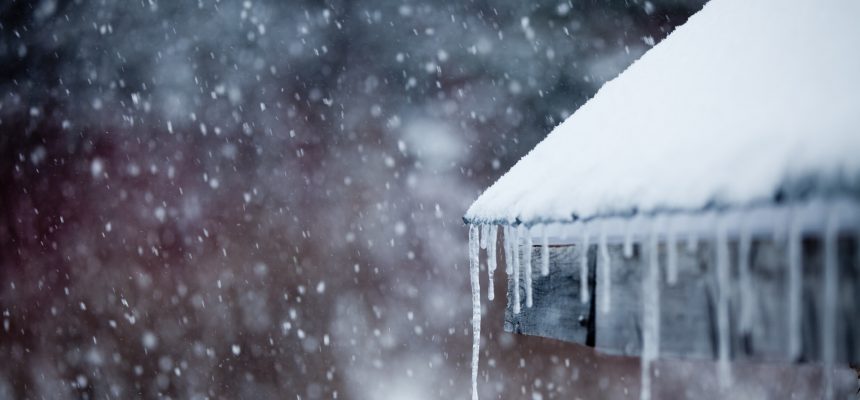An ice dam can form when the snow accumulated on your rooftop melts, runs down the roof, and re-freezes near the edge. When this happens, this can prevent melted snow from draining, leading to water buildup, leaks, and structural damage.
Ice dams can only form if the roof’s edge sits lower than the rest of the roof, allowing the melted snow to run down the slope of the rooftop. In order for the snow to melt to form an ice dam, a part of the roof must be warmed above 32°F. One of the primary causes of ice dam formation is a warm attic. Overlooking an ice dam on your rooftop could lead to significant, and possibly permanent, damage.
In cold, snowy areas, ice dams can be a significant issue. However, there are some things you can do to eliminate, or at least mitigate, the risk of ice damming on your roof. No, you won’t be able to stop the snow from falling, but it is possible to keep the snow from melting and running down the roof to form ice dams.
How Do Ice Dams Form?
When it’s cold outside, you probably have your heater running inside to stay warm. If you do not have any insulation in your attic, the warm air from your home could seep into the attic.
Ultimately, this ends up heating the underside of your roof. If there is a lot of snow accumulation on the roof, it’s almost like a blanket with several layers. The warm air in the attic ends up heating the rooftop and the layer of snow sitting upon it, leading it to melt into water that can drip down the slope of the roof. The water runs down your shingles until it reaches the cold overhang and re-freezes, forming the ice dam.
If you experience excessive snowfall at your home, it’s important to take measures to prevent ice damming on your roof to avoid damage and leaks. The ice dams will grow, acting as a block to stop accumulated snowmelt from draining. The water on the rooftop will get higher, increasing the risk of permanent damage to your shingles and roof.
Below are a few ways to prevent ice damming on your roof.
Steps to Prevent Ice Dams on Your Roof
Here are four actions you can take to keep ice dams from forming on your roof.
Remove Snow
The least expensive, most effective, and arguably, best way to prevent ice dams is to have no snow sitting on your roof. After all, no snow means there’s nothing to melt, and nothing to melt means no ice dams. That being said, it’s important to make sure you remove everything because anything left behind, even a thin layer, can melt and create ice dams.
Of course, it’s always important to hire a professional to clear snow from your roof.
A professional will have the required tools, such as a roof rake, to safely and effectively clear the snow. The tool used is always made of plastic or has bumpers in the wheels to ensure that your shingles are not damaged. Typically, the professional clearing the snow will work one layer at a time in small segments, so the more snow accumulation you have, the longer it will take.
This task is not hard, but it is time-consuming and repetitive, so these services can sometimes be expensive, depending on location. However, if you wait until ice dams have formed, it may be too late to hire somebody to clear the rooftop.
Address any Trees and Branches Overhanging Your Roof
This is something that is commonly overlooked, but if you have trees or branches overhanging your roof, it can significantly contribute to ice dam formation.
Tall trees are great to have during the summer, as they act as additional insulation and protect your home from the sun, but during winter, they can be harmful. The areas on your roof that are shadowed by the trees will be 5° to 15° cooler than the areas that are not. When the snow melts and runs down the roof, it will re-freeze when it hits these shaded areas, forming ice dams.
If you want to prevent these cold spots on your rooftop, take some time to trim the trees and branches that overhang your roof. This way, your roof will be at the same temperature all around, preventing cold spots.
Don’t Allow Your Roof to Get Too Hot
When you turn on the heat in your home, the rooms will be warmed, and the heat will rise, ultimately escaping into the attic. The heat will collect in the attic, heating the roof. This creates a large difference between the inside and outside temperatures. When the underside of the roof gets hot, the layer of snow touching the roof melts and slides down the roof to the colder edges. The colder area will re-freeze the water, creating ice dams.
To prevent this, there are several things you can do:
- Add or improve insulation in the attic
- Check ventilation and improve or add to it as needed
Conclusion
To keep your home safe and free of damage, it’s a good idea to go through the steps in this article to prevent ice dams.
If you think you might have some issues with ice damming on your roof, contact A&J Reliable for a free roof inspection. We will be happy to help you understand what needs to be done to help with the prevention of ice damming.





